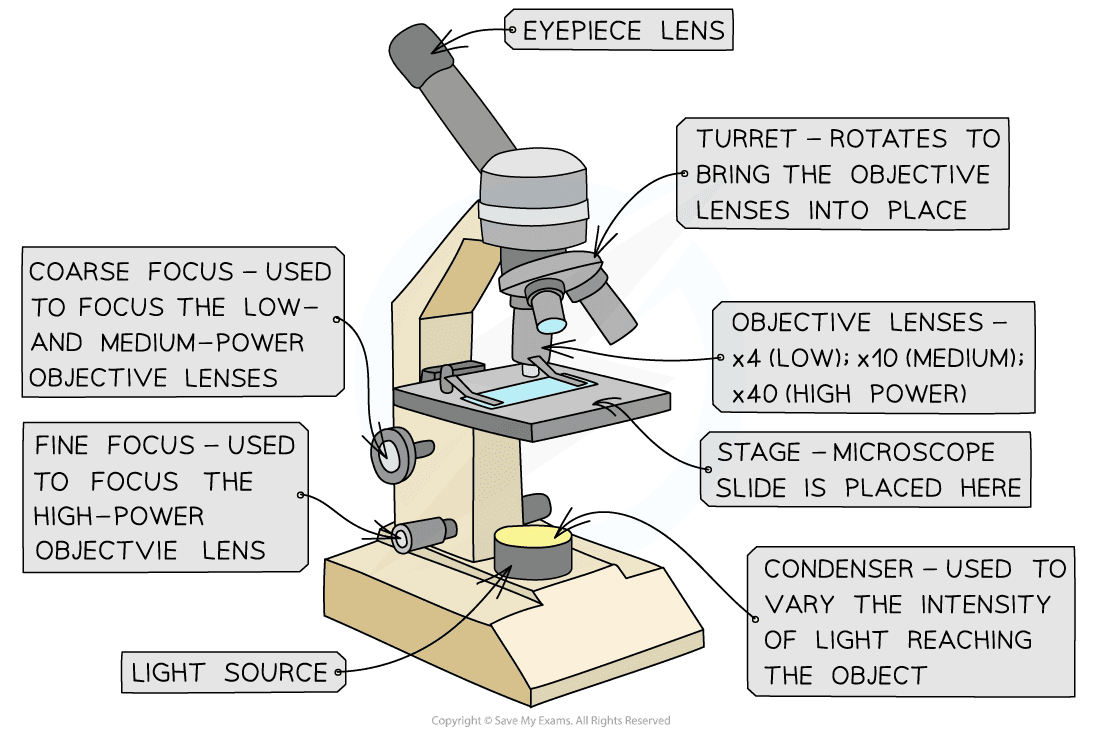Practical: Microscopy
- Many biological structures are too small to be seen by the naked eye
- Optical microscopes are an invaluable tool for scientists as they allow for tissues, cells and organelles to be seen and studied
- Light is directed through a thin layer of biological material (containing the tissue(s), cell(s) or organelle(s) to be observed) that is supported on a glass slide
- This light is focused through several lenses so that an image is visible through the eyepiece
Apparatus
- The key components of an optical microscope you will need to use are:
- The eyepiece lens
- The objective lenses
- The stage
- The light source
- The coarse and fine focus
- Other apparatus used:
- Forceps
- Scissors
- Scalpel
- Coverslip
- Slides
- Pipette
The components of an optical microscope
Method
- Specimens must be prepared on a microscope slide to be observed under a light microscope
- This must be done carefully to avoid damaging the biological specimen and the structures within it
- The most common specimens to observe under a light microscope are cheek cells (animal cells) and onion cells (plant cells)
- Preparing a slide using a liquid specimen:
- Add a few drops of the sample to the slide using a pipette
- Cover the liquid/smear with a coverslip and gently press down to remove air bubbles
- Wear gloves to ensure there is no cross-contamination of foreign cells
- Preparing a slide using a solid specimen:
- Use scissors to cut a small sample of the tissue
- Peel away or cut a very thin layer of cells from the tissue sample to be placed on the slide (using a scalpel or forceps)
- Some tissue samples need to be treated with chemicals to kill/make the tissue rigid
- Gently place a coverslip on top and press down to remove any air bubbles
- A stain may be required to make the structures visible depending on the type of tissue being examined. Commonly used stains include methylene blue to stain cheek cells and iodine to stain onion cells
- Take care when using sharp objects and wear gloves to prevent the stain from dying your skin
- When using an optical microscope always start with the low power objective lens:
- It is easier to find what you are looking for in the field of view
- This helps to prevent damage to the lens or coverslip in case the stage has been raised too high
- Preventing the dehydration of tissue:
- The thin layers of material placed on slides can dry up rapidly
- Adding a drop of water to the specimen (beneath the coverslip) can prevent the cells from being damaged by dehydration
- Unclear or blurry images:
- Switch to the lower power objective lens and try using the coarse focus to get a clearer image
- Consider whether the specimen sample is thin enough for light to pass through to see the structures clearly
- There could be cross-contamination with foreign cells or bodies
Care must be taken to avoid smudging the glass slide or trapping air bubbles under the coverslip
Results: using a graticule to measure cells, cell structures and organelles
- In order to take measurements of cells, you need to use a calibrated graticule
- An eyepiece graticule and stage micrometer are used to measure the size of the object when viewed under a microscope
The three lines of a stage micrometer and the 100 division-markings of the eyepiece graticule, as seen if looking down the lens of a light microscope
Results – producing labelled scientific drawings from observations
- Producing biological drawings of what you see under the microscope is a key skill
- The key is not to try to be too artistic with your drawings – they are supposed to be scientific so make sure you follow the rules
Biological drawings should be as large as possible – aim to take up at least half of the space available on the page with your drawings
Limitations
- The size of cells or structures of tissues may appear inconsistent in different specimen slides
- Cell structures are 3D and the different tissue samples will have been cut at different planes resulting in inconsistencies when viewed on a 2D slide
- Optical microscopes do not have the same magnification power as other types of microscopes and so there are some structures that cannot be seen
- The treatment of specimens when preparing slides could alter the structure of cells




